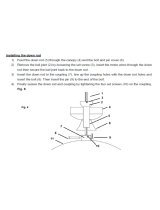
19308972
GH5030 Parts List
REF
NO. PART NO. DESCRIPTION QTY
REF
NO. PART NO. DESCRIPTION QTY
1 107074 BREATHER, fill cap 1
2 106114 STRAINER, inlet 1
3 107053 ELBOW, pipe, 90_, 1/2 x 3/8 npt 1
4 107128 TEE, service 1
5 107050 INSERT, hose, 1/2 npt(f) 3
7 178859 HOSE, rubber, 5 in. (125 mm) 1
8 102473 CLAMP, hose 6
9 210658 VALVE, ball 3/8 npt(m) 1
10 165472 ELBOW, pipe, 90_, 3/8 npt(f) 1
11 106039 WHEEL 2
12 106123 CAPSCREW, hex hd, 1/2 x 4 in. 4
13 100018 LOCKWASHER, spring, 1/2 in. 4
14 100321 NUT, hex, 1/2 in. thread 4
15 188344 NIPPLE, pipe, reducing, 3/8 x 1/2 npt 1
16 103475 TEE, pipe, 1/2 npt(f) 1
17 158491 NIPPLE, short, 1/2 npt 1
18 107052 FITTING, tube, flared 1
19 115753 BATTERY, 12 volt, “L” style terminals 1
20 107069 CLAMP, battery 1
21 101354 PIN, stra ight, spring 2
22 513575 HOSE, coupled 3/4 in. X 30 in. 1
23 178751 GUARD, fan 1
24 179714 SPACER 1
25 100213 NIPPLE, pipe, 3/8 npt x 3 in. 1
26 217469 FRAME, pump 1
27 101578 CAPSCREW, hex head, 8--32 x 0.38 in. 4
28 100214 LOCKWASHER, spring, 5/16 in. 19
29 217022 MOTOR, hydraulic, Manual 307158 1
30 177755 LABEL, identification 1
31 110838 NUT, lock, 5/16--18 6
32 625057 Bracket, hydraulic motor 2
33 158586 REDUCER, 1 in. 2
34 177652 HANDLE 1
35 168210 NUT, shouldered 1
36 168211 COUPLING, connecting rod 1
37 500566 TEE 2
38 111337 TEE, 1 in. npt(f) 1
39 100505 BUSHING, pipe 1
40 107129 BOLT, carriage, 5/16 in. x 1 in. 1
41 107073 CABLE, battery, positive, 26 in., 6 awg 1
43 513631 KIT, suction, GH roofing rig 1
44 513549 ADAPTER, male quick disconnect 1
45 116976 ELBOW, street, pipe, 90_ 1
46 570183* PUMP, displacement;
L220C1 220cc 900 std 1
47 198592 ROD, Tie, 14.59 in. shoulder to shoulder 3
48 101712 NUT, lock, type “E” 5/8 in.-- 11 3
49 100101 Screw, Hex HD 3/8--16 X 1 in. 5
50 104444 O--RING, fluoroelastomer 1
51 104126 PLUG, box, 3/4 in. 1
52 107049 INSERT, hose, 3/4 npt(f) 1
53 178791 HOSE, suction, 1 in. ID, 3’ (9.9 m) 1
54 101818 CLAMP, hose, 13/16 in. to 1 --1/2 in. OD 2
55 178773 LEG, frame 1
56 177641 WASHER, flat 2
57 177570 AXLE 1
58 113951 CABLE, battery, negative, 8 in., 6 awg 1
59 107068 HOOK, bolt, 1/4 in. thread 1
60 15C713 PLATE, engine 1
61 216141 SUPPORT, engine 1
62 100468 CAPSCREW, hex hd, 3/8 x 1.5 in. 4
63 104766 MOUNT, motor 4
64 100023 WASHER, 3/8 in. 18
65 177765 PLUG, handle 2
67 100678 CAPSCREW, hex hd, 5/16 X 1.75 in. 4
68 803444 DAMPENER, pulsation 1
70 244819 COUPLING, assy 2
71 218125 RESERVOIR KIT 1
72 185951Y LABEL, DANGER 1
73 184471 COUPLER 1
74 100188 NUT, heavy hex, 5/16--18 unc--2a 11
75 177807 LABEL, identification 1
76 106053 ELBOW, 90_, 1 --1/16 in. thread 1
77 513574 HOSE, coupled 1 in. X 20 in. 1
78 107127 ADAPTER, male, 1 --5/16 in. x 3/4 in. 1
79 620188 ADAPTER, 1 in. (m) x3/4 x 1 /2 x 3/8 (f) 1
80 197341 COLLAR coupling 2
81 157785 UNION 3/4 in. (M)--(F) Straight 1
82 105430 NUT, seal, 1 in. npt 1
83 15C712 SHIELD, heat 1
84 158586 BUSHING, 3/4 in. X 1 in. npt 1
85 178795 HOSE, cooler, 0.625 in., 10.5 in. lg 1
86 158555 NIPPLE 1
87 177808 LABEL, identification 1
88 178935 LABEL, caution 1
89 100103 PIN, cotter, 0.125 in. dia, 1.5 in. long 2
90 101936 NUT, hex jam, 3/4 in.--10 1
91 168212 ROD, connecting 1
92 158674 PACKING, o --ring, buna --n 1
93 107125 ELBOW, 90_ street, 3/4 npt(m) 1
94 105429 NUT, seal, 3/4 npt 1
95 178750 FITTING, return, 1 in. npt(m) x 3/4 npt(f) 1
96 178794 FILTER, fluid 1
97 500054 BUSHING, hex hd 1
98 107067 O--RING, buna --n 1
99 100086 WASHER 3
100 106212 SCREW, cap 2
101 196666 LABEL, ID 1
102 112179 SCREW, mach 3
103 112798 SCREW, mach, hex washer hd, 8 x 3/8 in.1
104 LABEL, identification 1
105 219099 KNOB, pump 1
106 100187 NUT, hex, 5/16 in. 1
107 178872 PUMP, vane, hydraulic 1
108 100421 SETSCREW, 5/16 in. X 3/8 in. 2
109 106063 COUPLER 2
110 605358 KEY, 1/4 in. 1
111 113287 ENGINE, 18 HP, OHC 1
112 107143 CAPSCREW, sch, 7/16 x 1.25 in. 4
113 100052 LOCKWASHER, spring, 7/16 in. 4
114 178792 BLOWER 1
115 178788 COOLER 1
116 178861 PAD 2
117 178786 SUPPORT, pump 1
118 802277 CAPSCREW, hex hd, 5/16 x 1.5 4
119 100016 LOCKWASHER, spring, 1/4 in. 3
120 100011 WING NUT, 1/2 in. 2





















